Exchange rate: Rand 1 (R1) = Hungarian Forint 18,43 (18,43 Ft)
31 July 2023 - 5 August 2023, Budapest, 54.75km
Camping Arena 10,395Ft [R563]
Our accommodation budget has morphed on this trip from 200 Moroccan dirham to 100 Polish zloty to 540 Czech crown to 22 Euro to 8,700 Hungarian forint*.
Getting our heads around a new currency is always a brain-teaser during the first couple of days in a new country. Shortly before leaving home on this trip, I discovered the best ever currency converter app, Currency Plus. It displays several currencies of your choice at any one time and makes conversions and comparisons super easy. Try it next time you travel.
*"Forint (HUF) has been the local currency in Hungary since August 1946. It was named after the city of Florence, where golden coins had been minted since 1252."
--
Instead of continuing along the Eurovelo 6 cycle route into Budapest, we opted to take the road (routes 11, 111, 117 and 10) thereby cutting 30km from the distance.
We crossed the Danube twice. Once over the river border between Slovakia and Hungary, and once at the northern end of Budapest. From the border bridge we had wonderful views of the Esztergom Basilica (Primatial Basilica of the Assumption of the Blessed Virgin Mary and St Adalbert). Having visited the Basilica in 1999, we chose to admire it in passing only. Having subsequently read more about it, we are sorry to have done so. It is the largest church in Hungary with a "reverberation time of over 9 seconds", and it has the largest painting on a single canvas in the world.
Having crossed the river again into the capital, we avoided the killing zone and did the last 11km on city cycle paths, some with dedicated mini traffic lights!
--
We stink! Our shoes and socks were still wet when we forced our reluctant feet into them shortly before crossing the bridge into Hungary. Add a humid day and lots of footwork, and things tend to get smelly…
--
It was late afternoon when we arrived yesterday at Camping Arena in the eastern suburbs of Budapest. We were tired and hungry and very disturbed to find their price for the night was half again as much as our accommodation budget. As we need to spend several nights in the city, I asked for and was granted a discount. The price is still over our budget, but is mitigated by a couple of things. Firstly, using the washing machine is free and they will even provide washing powder if you don't have. Secondly, it seems that all public transport is free to those over 65, so we can commute without putting a strain on our finances. Thirdly, there is an excellent Spar supermarket 800m away with enough variety to make self-catering an affordable pleasure.
--
I assume every sensible person operates on a budget, whether at home or travelling. In some cases the budget will be magnanimous, in others parsimonious. At home, we live carefully but relatively well. In Europe, coming in on budget is an interesting exercise in humility. We currently shop with a calculator in hand, deducting from our food budget each item as it goes in the basket and revelling at having sufficient in hand for a Bounty chocolate. Charl shops for beer exclusively by price, bringing him a variety of makes and strengths depending on the country or shop. That we can afford beer and Bounty tells you we are doing OK!
--
Last night we found and set up camp on a nice corner site. This morning, we discovered a bench and table and firepit next to an open site and decided to move home. As we were placing our tent on the site, the groundsman arrived with bags of soil and grass seeds and a rake intent on revamping our chosen spot. He knew no English except "no-no-no, no-no-no". To emphasise his point, he went away, returning with red and white chevron tape and taping off the area. He did point us to a nearby alternative where we placed the tent and strung a long wash line for our freshly-laundered clothes and sheets. (Washing by hand simply ain't the same as washing by machine!)
Shortly after our morning nap (!), people departed the only other site next to the bench and table, so we moved home yet again. Somewhere to sit and our very own electrical charging point and all within a very short walk of the ablutions, kitchen and laundry. Fab.
--
Camping at an official campground is an oddly intimate experience. One is packed close enough to hear others snore and fart in the night (and presumably vice versa) and one arises to see other sleep-sodden campers getting up to pee and brush their teeth. The smell of other people's cooking is enticing (or off-putting - last night our neighbour cooked Bully Beef; I may be alone in this, but I hate the cat-food smell of Bully Beef) and they know, should they choose to look, exactly what mustard you are spreading on your roll! And yet there is a culture of giving people their space by not staring, while still somehow being open to friendly greetings. A bit of an art form.
--
It has poured with rain the last two nights. We have managed to stay dry (ish), but others have stepped from their campers into or found their tents in ankle-deep water. Last night a branch broke off a tree and fell on the tent of a dad and his son in town for a judo championship. Luckily they had a car to transfer to. The photo is of our in-between site…
--
Romanian VISA saga...
We're going nowhere slowly and getting there fast!
Remember that we were turned away in Prague and told we had to apply online for a Romanian visa? Remember that once we had entered our place of residence online, we were given the option of applying via Pretoria only?
Pretoria does not answer the phone or respond to emails that initially asked them to forward our application to Bratislava.
Remember the Bratislava embassy has stopped issuing visas?
Later emails to Pretoria were about them forwarding the application to the Romanian embassy in Budapest instead.
When Pretoria finally responded it was not about forwarding our application elsewhere, but to say "Acording to the Romanian law, you must prove the accommodation for the entire period of stay". This is simply not possible on a bike, as I had explained, using the same letter that had bagged us a Schengen visa.
Having written a lengthier explanation than that first supplied, I found that the visa application site had an internal error which allowed me to update Charl's application but not mine.
When we decided to bypass the online / Pretoria process and go direct to the Budapest embassy, it was to find a note on the wall outside the gate saying the embassy is no longer issuing visas!
We finally got someone to open the door in the wall, who said we need to apply in Szeged, a town in Hungary near the Romanian border.
We begin the three-day trip there tomorrow.
Here's the problem. We have to resolve departing Schengen Europe before our visa expires August 26. If we can't get a Romanian visa, we have two options: Bosnia or Serbia, both of which presumably require visas…
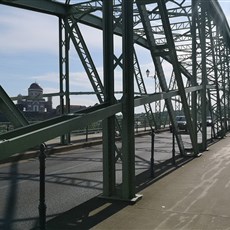
Crossing the Danube at Esztergom
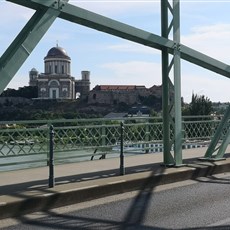
Crossing the Danube at Esztergom
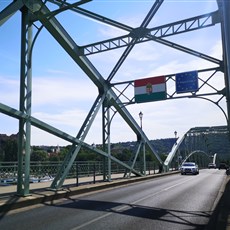
Crossing the Danube at Esztergom
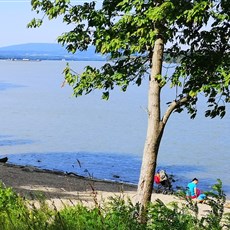
Esztergom to Budapest
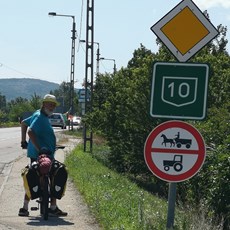
Esztergom to Budapest
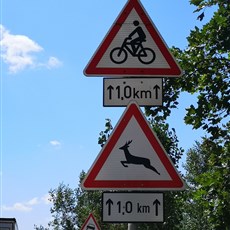
Esztergom to Budapest
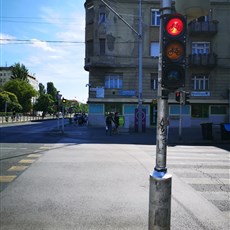
Budapest